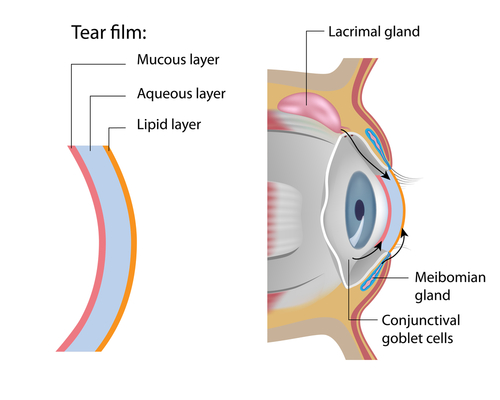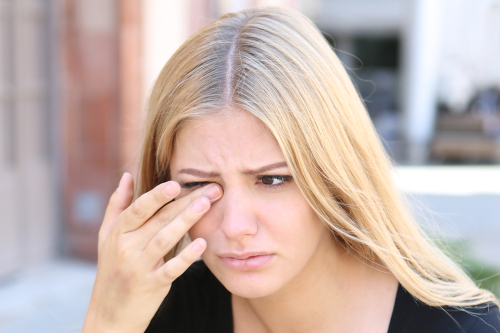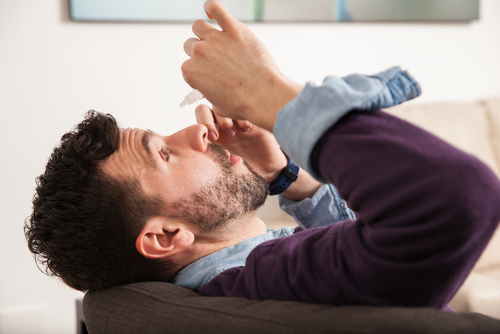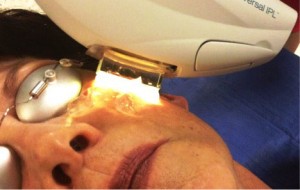Are your eyes dry, itchy, or irritated? These are some of the symptoms associated with a chronic condition called dry eye syndrome.
As many as 50 million Americans are affected by dry eye syndrome, one of the most common eye conditions. You may experience a range of symptoms that cause discomfort regularly.
Not sure what to do to make your eyes feel better? Keep reading to learn about 9 of the most common dry eye syndrome symptoms and how to treat them to find the relief you need!
What Is Dry Eye Syndrome?

Dry eye syndrome is a chronic disease that occurs when the eyes do not provide enough lubrication. The cause can be an inability to produce enough tears, or the tears you produce are low in quality. This leads to irritation on the surface of the eye, along with other frustrating symptoms.
Your risk of developing dry eye syndrome increases with age because the eye’s ability to produce tears can decline over time. Using contact lenses can also increase your risk. Certain diseases like Sjogren’s syndrome and rheumatoid arthritis can also decrease tear production in rarer cases.
9 Common Symptoms of Dry Eye Syndrome
The symptoms associated with dry eye syndrome can range from mild irritation to an overall decrease in your quality of vision. The most common signs include:

- Dryness: This tell-tale indicator of dry eye syndrome results from a lack of sufficient tear production.
- Redness: Without adequate lubrication, the surface of the eye can become inflamed.
- Eye pain: Because the eyes aren’t producing enough moisture, the surface of the eye becomes more susceptible to abrasions, which can be quite painful.
- A burning, gritty, or stinging sensation: Irritation caused by dry conditions can worsen throughout the day and may feel like your eyes are burning, stinging, or filled with grit.
- A foreign body sensation in the eye: Many people with dry eye syndrome say it feels like they have sand or small particles stuck in their eyes.
- Watery eyes: Although it seems the opposite of what you would experience, watery eyes can occur when dryness leads the eye to produce excess tears. These tears will usually lack a crucial component, like oil, making them evaporate from the surface of the eye more quickly.
- Light sensitivity: People who have dry eyes may have light sensitivity, especially around computer screens and bright sunlight.
- Blurry vision: If you have dry eye syndrome, things you’re looking at may not appear as sharp, or everything may seem like it’s out of focus to some degree.
- Decreased night vision: As the pupil enlarges in low-light conditions, objects can become fuzzy.
Ways to Relieve Dry Eye Symptoms at Home
Several home remedies can help alleviate the symptoms of dry eye syndrome. For some people with dry eyes, these remedies can be enough to relieve their symptoms.
Apply a Warm Compress
You can try applying a warm compress to your eyes for at least a minute to help soothe any inflammation or irritation. Applying a warm compress or washcloth can help open up the meibomian glands in your eyes responsible for producing tears.
Stay Hydrated
Proper hydration is beneficial for every part of your body, including the level of moisture in your eyes. To stay hydrated, aim for eight to ten glasses of water every day.
Make sure that plenty of water is always within reach no matter where you are. If you find it challenging to drink enough water, you can also add more foods with water content to your diet.
Try to eat things like celery, watermelon, oranges, bell peppers, cucumber, and lettuce. Not only will you be adding more hydration to your daily intake, but you’ll also be eating more fruits and vegetables at the same time!
Make Sure You Consume Enough Omega-3 Fatty Acids
Another way to help promote healthy tear production is to add naturally oily fish to your diet. The omega-3 fatty acids present in fish like salmon and tuna are helpful for the oil-producing glands in the eye because the tears are made up of three parts: oil, water, and mucus.
Incorporating more of this healthy oil can make a big difference if you have dry eye syndrome. If you don’t like fish, try adding in flaxseed oil, chia seeds, walnuts, and eggs as well.
You can also take an omega-3 supplement in the form of fish oil, but getting your nutrients naturally in your daily diet is better when possible.
Put a Humidifier in Your Home
Humidifiers can be helpful if you have dry eye syndrome. Try placing them in rooms where you spend the most time, like your bedroom.
Otherwise, the air circulating in your home can be dry and only exacerbate your symptoms. During colder winter months, this is especially true when you’re using your heat. Using a humidifier can help add necessary moisture back into the air, reducing dry eye symptoms.
Use Eye Drops or Artificial Tears

Eye drops or artificial tears can provide you with the lubrication your eyes are missing. Some patients take them once a day, and others need to use them several times a day.
Since there are many over-the-counter options available, our team at Dell Laser Consultants is happy to make a recommendation about the best one for you.
Treating Dry Eye
If your dry eye is severe enough to be affecting your day-to-day quality of life, home remedies may not be enough. In that case, you may need to consider treatment options.
The talented eye doctors at Dell Laser Consultants can prescribe various drops, gels, and ointments to provide relief from your dry eye symptoms. For example, Xiidra is one type of eye drop that can reduce inflammation and increase tear production.
We also offer eyelid drainage plugs, called punctal plugs. These help to maintain more tears in the eye, often eliminating the need for artificial tears.
Punctal plugs are so small that they are invisible to the naked eye. It only takes a few minutes to insert them. They are painless and come in both temporary and permanent forms.
Another treatment is called the TearCare System®. The TearCare System® uses a combination of wearable and smart technology to deliver heat while allowing the eyelids to blink naturally.
TearCare® can be highly effective for patients with meibomian gland dysfunction, dry eye syndrome, or blepharitis. The system uses SmartLids and a SmartHub to treat these conditions.
The BlephEx™ eyelid treatment reopens glands in the eye to stimulate healthy tear production. Over time, debris can accumulate and block these glands from producing adequate tears. It can relieve dry eye symptoms for up to six months.

Another effective treatment for dry eye syndrome patients offered at Dell Laser Consultants is intense pulsed light therapy (IPL). IPL can be helpful for patients with rosacea, but it has also been shown to treat the underlying cause of meibomian gland dysfunction and dry eye syndrome.
Dell Laser Consultants pioneered the clinical research trial on IPL and is currently adding qualified patients to our ongoing study at The Institute for Dry Eye Research.
Are you tired of frustrating dry eye symptoms holding you back? Schedule an appointment at Dell Laser Consultants in Austin, TX, to find the relief you need and help your eyes feel better!





